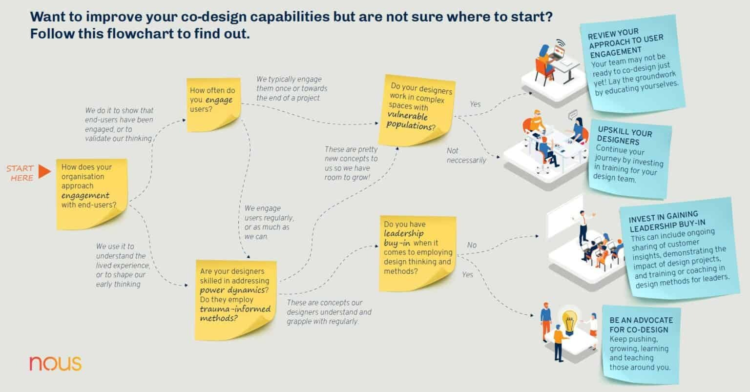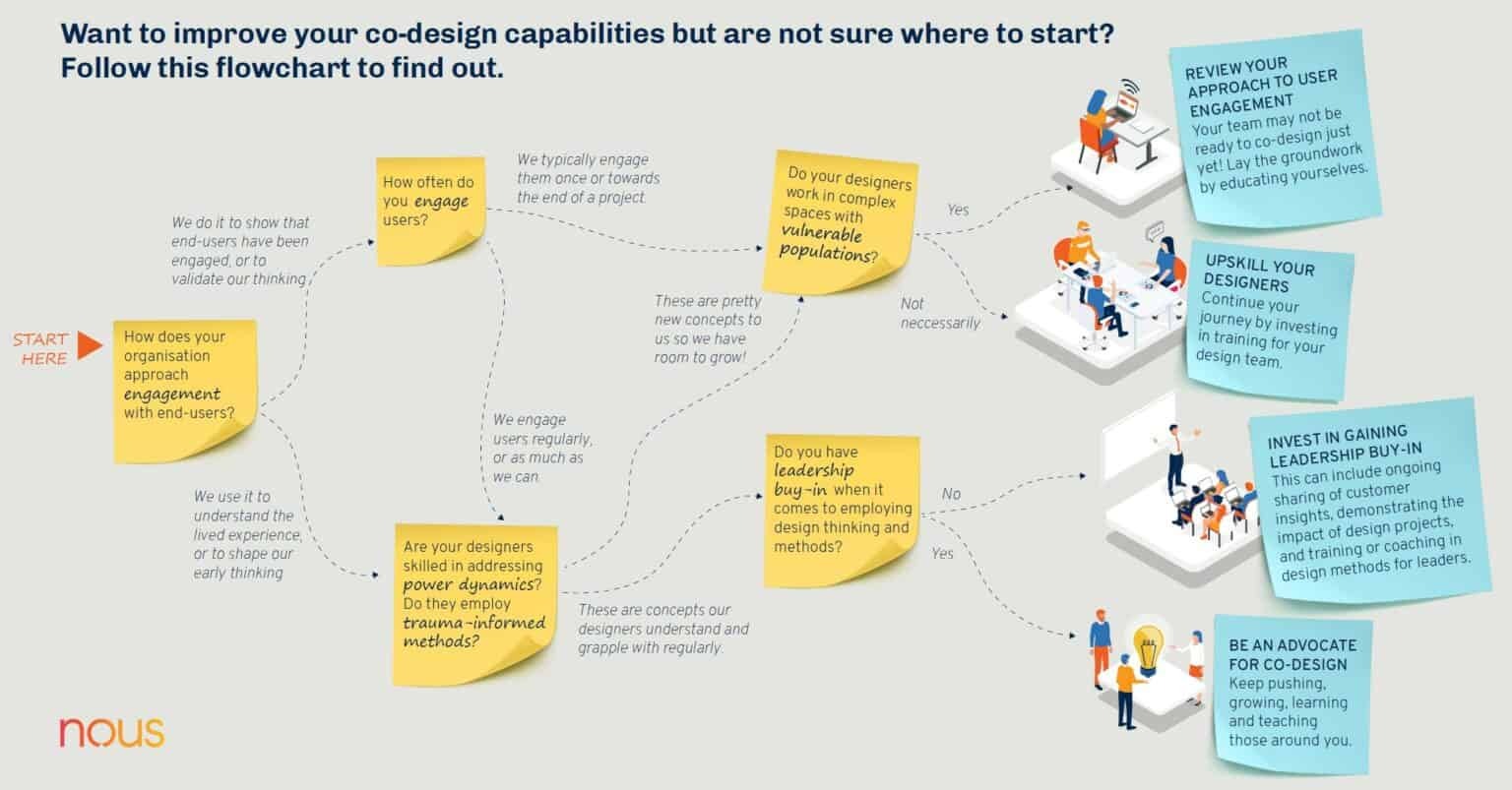Idea In Brief
New way of working
Putting co-design into practice demands opening to a new way of working: giving away power to end-users with lived experience, trusting them to be involved in decision-making and to contribute to developing solutions for the problems at hand.
Five factors
We have identified five readiness factors: Be clear on the value of end-user engagement; Empower users to participate as equals; Meet users where they are with a trauma-informed approach; Ensure your team’s readiness; Consider the organisation and its culture.
Gets results
Engaging in co-design creates positive ripple effects, including giving a voice to those overlooked by a system, allowing users and communities to feel empowered and building more trust. The result is more active and positively engaged communities.
These days it feels like every organisation says it is keen to practise co-design. But for most, this is a new journey and it is easy to fall back into methods that are closer to consultation than to co-design.
Putting co-design into practice demands opening to a new way of working: giving away power to end-users with lived experience, trusting them to be involved in decision-making and to contribute to developing solutions for the problems at hand.
At Nous we have used co-design with many organisations – from universities to local governments and banks – to help them meet some of their biggest challenges. Drawing on that experience, we have identified five factors that are crucial to understanding your readiness for co-design. We are pleased to share these factors – and the questions to ask for each one.
1. Be clear on the value of end-user engagement
Start by creating a clear shared understanding of what you hope to get out of engaging end-users in the design process. Engagement remains consultative when the priority is merely to show that the end-user has been engaged, to fill gaps in knowledge, or to test ideas you have already come up with.
On the other hand, if you seek truly user-centric solutions with longevity, you must facilitate the participation of users – the experts in their lived experience – through co-design methods. Experts are no substitute for lived experience, and you need to involve both. This is true in all cases, but especially when working with complex or sensitive topics or with vulnerable populations.
Questions to ask:
- How does your organisation or team typically approach engaging customers or end-users?
- How often and at what points do you bring end-users into the process of designing solutions meant for them?
- How ready are you to listen to and value end-users’ inputs alongside other inputs?
2. Empower users to participate as equals
Core to the concept of co-design is treating your end-users as equals in the process and valuing their expertise and input at every step. This means providing end-users with the right tools, context and information to participate effectively, and facilitating a process in which they can do so. Empowering your users also entails the designer being aware of who else is participating, the types of power at play, and any inherent power dynamics to be addressed.
Each co-design context has a unique power dynamic among participants, so needs to create a space that allows all participants to contribute. For example, consider if it is appropriate to bring clients and service providers together, and what impact that might have on different participants’ abilities to engage in the process.
Questions to ask:
- Do your designers recognise and address power dynamics when facilitating sessions?
- What techniques do you use to rebalance power in a space?
3. Meet users where they are
Ensure that all engagement considers participants’ safety, both physical and psychological. This can look very different in different contexts, depending on the participants. When working with vulnerable populations it is important to use a trauma-informed approach.
Methods may include:
- facilitating a safe and comfortable space for participation
- clearly communicating in advance what is being asked of your participants, who they will be engaging with and their roles, so they can come prepared
- empowering your participants in the way you engage them, which means framing the discussion in the context of the choices they have – for example, reinforcing their option to pause or stop at any point
- having experts such as social workers on hand to ensure someone is equipped to support a participant should they become distressed
- understanding where your participants are in their own experience and engaging them when they are ready and have the mental and emotional space to engage effectively
- exploring the role of a separate space that is exclusively for your participants to have the conversations they want to have.
Questions to ask:
- Are your designers aware of their own emotional states and able to practise self-care?
- What techniques are you using to create space for end-users to participate effectively and shape the conversation and the outputs?
- Are your engagement methods trauma-informed, culturally safe and strengths-based?
4. Ensure your design team’s readiness
The design process is non-linear, which can make it tricky to push back against deliverable-focused ways of working. Practising co-design means recognising this messiness, being comfortable with it, allocating time and resources to engage users, and making allowance for new insights to reshape the problem space.
Engaging with vulnerable groups adds complexity. Consider if your design team is ready to engage with sensitivity and self-awareness. They may require training and coaching.
Questions to ask:
- What is the current design capability and maturity of your team?
- Are your designers aware of the privilege and assumptions they might bring?
- Would your design team benefit from training, either in co-design methods, or in trauma-informed, culturally safe and strengths-based engagement methods?
5. Consider the wider organisation and its culture
An organisational culture that is collaborative, non-hierarchical, comfortable with ambiguity and open to new ideas will be best placed to engage in co-design.
In many organisations, power is concentrated at the top and the culture is risk-averse, making it more challenging to practise co-design. In many cases end-users are involved in research and workshops, but the balance of power and decision-making authority still rests with the project sponsors, experts or practitioners.
There is discomfort with giving away power. Exposing your leadership teams to different ways of thinking can alleviate this discomfort. New ways of thinking and working may involve bringing in speakers from adjacent industries to share their experiences, showcasing the value that co-design has brought to similar organisations, or engaging design leaders to facilitate workshops, coach or train leadership teams in co-design and other design methodologies.
Questions to ask:
- How can you influence your organisation’s culture through sharing end-user insights in powerful ways? How will your organisation respond to user insights and feedback?
- Is there benefit in engaging your organisation and leadership on the value of co-design and design methods?
- Would your design leadership and team benefit from hands-on training?
The benefits are valuable and extend beyond customer-centric solutions
For organisations designing services and solutions in complex spaces or working with vulnerable populations, co-design is valuable. The additional time and resources it might need will be far outweighed by the effectiveness and longevity of solutions that emerge from bringing together users with lived experiences who have diverse needs.
Co-design gives organisations a deeper understanding of and empathy for the user that extends beyond frontline staff and contributes to a customer-centric culture that can unite the organisation through a user-centric culture.
Engaging in co-design creates positive ripple effects, including giving a voice to those otherwise overlooked by a system, allowing users and communities to feel empowered to participate in creating solutions and building more trust in the organisation delivering the services.
The result is more active and positively engaged communities.
Get in touch to discuss how we can support you to achieve true co-design.
Connect with Trisha Santhanam on LinkedIn.
Prepared with input from Kirsty Elderton during her time as a Principal at Nous.




